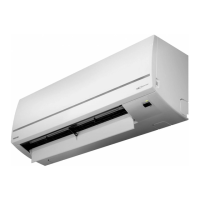High Wall, Heat Pump Type
Service Manual
31
Toshiba
8 OPERATION DESCRIPTION
8-1. Outline of Air
Conditioner Control
This air conditioner is a capacity-variable type air
conditioner, which uses DC motor for the indoor fan
motor and the outdoor fan motor. And the Variable
Cylinder Management Compressor (VCM Comp.)
which can change the motor speed in the range from
10 to 100 rps at 2 cylinder operation and the range from
10 to 50 rps at 1 cylinder operation is mounted. The DC
motor drive circuit is mounted to the indoor unit. The
compressor and the inverter to control fan motor are
mounted to the outdoor unit.
The entire air conditioner is mainly controlled by the
indoor unit controller.
The indoor unit controller drives the indoor fan motor
based upon command sent from the remote controller,
and transfers the operation command to the outdoor
unit controller.
The outdoor unit controller receives operation
command from the indoor unit side, and controls the
outdoor fan and the pulse motor valve. (P.M.V)
Besides, detecting revolution position of the
compressor motor, the outdoor unit controller controls
speed of the compressor motor by controlling output
voltage of the inverter and switching timing of the
supply power (current transfer timing) so that motors
drive according to the operation command.
And then, the outdoor unit controller transfers reversely
the operating status information of the outdoor unit to
control the indoor unit controller.
NOTE
As the compressor adopts four-pole brushless DC
motor, the frequency of the supply power from inverter
to compressor is two-times cycles of the actual number
of revolution.
8-1-1. Role of Indoor Unit
Controller
The indoor unit controller judges the operation
commands from the remote controller and assumes
the following functions.
• Judgment of suction air temperature of the indoor
heat exchanger by using the indoor temp. sensor.
(TA sensor)
• Judgment of the indoor heat exchanger temperature
by using heat exchanger sensor (TC sensor)
(Prevent-freezing control and super heat control,
etc.)
• Judgment of inlet indoor heat exchanger
temperature by using heat exchanger sensor (TCj
sensor)(Super heat control etc.)
• Judgment of suction air humidity of the indoor heat
exchanger by using humidity sensor. (Hu sensor)
• Louver motor control
• Indoor fan motor operation control
• LED (Light Emitting Diode) display control
• Transferring of operation command signal (Serial
signal) to the outdoor unit
• Reception of information of operation status (Serial
signal including outside temp. data) to the outdoor
unit and judgment/display of error
• Air purifier operation control
• Moving panel control
8-1-2. Role of outdoor unit
controller
Receiving the operation command signal (Serial
signal) from the indoor unit controller, the outdoor unit
performs its role.
• Detection of inverter input current and current
release operation
• Over-current detection and prevention operation to
IGBT module (Compressor stop function)
• Compressor and outdoor fan stop function when
serial signal is off (when the serial signal does not
reach the board assembly of outdoor control by
trouble of the signal system)
• Transferring of operation information (Serial signal)
from outdoor unit controller to indoor unit controller
• Detection of outdoor temperature and operation
revolution control
• Defrost control in heating operation (Temp.
measurement by outdoor heat exchanger and
control for 4-way valve and outdoor fan)
• Compressor operation control
• Operation control of outdoor
fan motor
• P.M.V. control
• 4-way valve control
Operations followed
to judgment of serial
signal from indoor
side.
+00A08-010_01EN_SVM_HighWallHeatPump.book Page 31 Wednesday, March 4, 2009 11:22 AM

